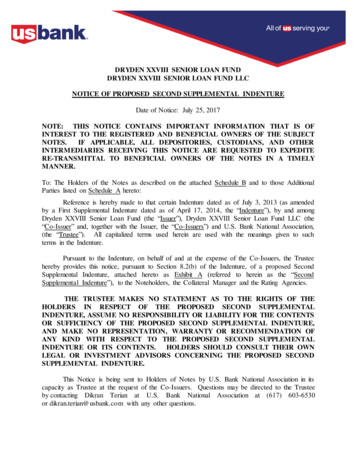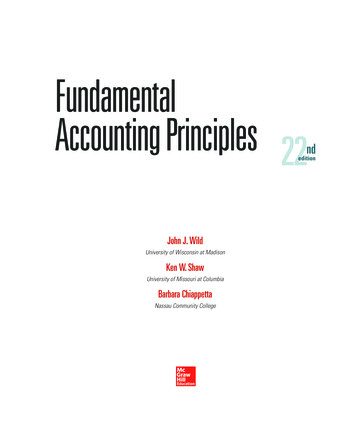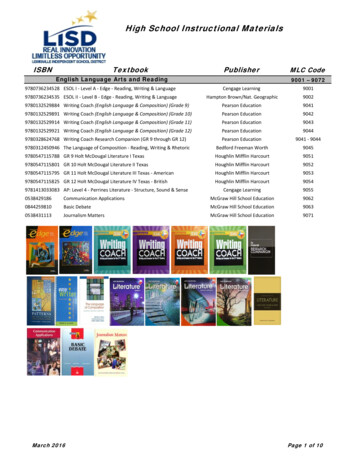
Transcription
Final PDF to printerInvestmentsbod61671 fm i-xxviii.indd i7/31/13 7:22 PM
Final PDF to printerThe McGraw-Hill/Irwin Series in Finance, Insurance and Real EstateStephen A. Ross, Franco Modigliani Professor of Finance and Economics, Sloan School of Management,Massachusetts Institute of Technology, Consulting EditorFinancial ManagementBlock, Hirt, and DanielsenFoundations of Financial ManagementFifteenth EditionBrealey, Myers, and AllenPrinciples of Corporate FinanceEleventh EditionBrealey, Myers, and AllenPrinciples of Corporate Finance,Concise EditionSecond EditionBrealey, Myers, and MarcusFundamentals of Corporate FinanceSeventh EditionBrooksFinGame Online 5.0BrunerCase Studies in Finance: Managing forCorporate Value CreationSeventh EditionCornett, Adair, and NofsingerFinance: Applications and TheorySecond EditionCornett, Adair, and NofsingerM: FinanceSecond EditionDeMelloCases in FinanceSecond EditionGrinblatt (editor)Stephen A. Ross, Mentor: Influence throughGenerationsGrinblatt and TitmanFinancial Markets and Corporate StrategySecond EditionHigginsAnalysis for Financial ManagementTenth EditionKellisonTheory of InterestThird EditionRoss, Westerfield, and JaffeCorporate FinanceTenth Editionbod61671 fm i-xxviii.indd iiRoss, Westerfield, Jaffe, and JordanCorporate Finance: Core Principlesand ApplicationsFourth EditionRose and MarquisFinancial Institutions and MarketsEleventh EditionRoss, Westerfield, and JordanEssentials of Corporate FinanceEighth EditionSaunders and CornettFinancial Institutions Management: A RiskManagement ApproachEighth EditionRoss, Westerfield, and JordanFundamentals of Corporate FinanceTenth EditionSaunders and CornettFinancial Markets and InstitutionsFifth EditionShefrinBehavioral Corporate Finance: Decisionsthat Create ValueFirst EditionInternational FinanceWhiteFinancial Analysis with an ElectronicCalculatorSixth EditionEun and ResnickInternational Financial ManagementSixth EditionReal EstateInvestmentsBrueggeman and FisherReal Estate Finance and InvestmentsFourteenth EditionBodie, Kane, and MarcusEssentials of InvestmentsNinth EditionLing and ArcherReal Estate Principles: A Value ApproachFourth EditionBodie, Kane, and MarcusInvestmentsTenth EditionFinancial Planning and InsuranceHirt and BlockFundamentals of Investment ManagementTenth EditionJordan and MillerFundamentals of Investments: Valuationand ManagementSixth EditionStewart, Piros, and HieslerRunning Money: Professional PortfolioManagementFirst EditionSundaram and DasDerivatives: Principles and PracticeFirst EditionFinancial Institutions and MarketsRose and HudginsBank Management and FinancialServicesNinth EditionAllen, Melone, Rosenbloom, and MahoneyRetirement Plans: 401(k)s, IRAs, and OtherDeferred Compensation ApproachesEleventh EditionAltfestPersonal Financial PlanningFirst EditionHarrington and NiehausRisk Management and InsuranceSecond EditionKapoor, Dlabay, and HughesFocus on Personal Finance: An ActiveApproach to Help You Develop SuccessfulFinancial SkillsFourth EditionKapoor, Dlabay, and HughesPersonal FinanceTenth EditionWalker and WalkerPersonal Finance: Building Your FutureFirst Edition7/31/13 7:22 PM
Final PDF to printerInvestmentsTENTHEDITIONZVI BODIEBoston UniversityALEX KANEUniversity of California, San DiegoALAN J. MARCUSBoston Collegebod61671 fm i-xxviii.indd iii7/31/13 7:22 PM
Final PDF to printerINVESTMENTS, TENTH EDITIONPublished by McGraw-Hill Education, 2 Penn Plaza, New York, NY 10121. Copyright 2014 by McGraw-HillEducation. All rights reserved. Printed in the United States of America. Previous editions 2011, 2009, and2008. No part of this publication may be reproduced or distributed in any form or by any means, or stored ina database or retrieval system, without the prior written consent of McGraw-Hill Education, including, but notlimited to, in any network or other electronic storage or transmission, or broadcast for distance learning.Some ancillaries, including electronic and print components, may not be available to customers outside theUnited States.This book is printed on acid-free paper.1 2 3 4 5 6 7 8 9 0 DOW/DOW 1 0 9 8 7 6 5 4 3ISBN 978-0-07-786167-4MHID 0-07-786167-1Senior Vice President, Products & Markets: Kurt L. StrandVice President, Content Production & Technology Services: Kimberly Meriwether DavidManaging Director: Douglas ReinerExecutive Brand Manager: Chuck SynovecExecutive Director of Development: Ann TorbertDevelopment Editor: Noelle BathurstDirector of Digital Content: Doug RubyDigital Development Editor: Meg B. MaloneyDigital Development Editor: Kevin ShanahanExecutive Marketing Manager: Melissa S. CaughlinContent Project Manager: Bruce GinSenior Buyer: Michael R. McCormickDesign: Debra KubiakCover Image: Aleksandar Velasevic/Getty ImagesTypeface: 10/12 Times RomanCompositor: Laserwords Private LimitedPrinter: R. R. DonnelleyAll credits appearing on page or at the end of the book are considered to be an extension of the copyright page.Library of Congress Cataloging-in-Publication DataBodie, Zvi.Investments / Zvi Bodie, Boston University, Alex Kane, University of California,San Diego, Alan J. Marcus, Boston College.—10th Edition.pages cm.—(The McGraw-Hill/Irwin series in finance, insurance and real estate)Includes index.ISBN-13: 978-0-07-786167-4 (alk. paper)ISBN-10: 0-07-786167-1 (alk. paper)1. Investments. 2. Portfolio management. I. Kane, Alex. II. Marcus, Alan J. III. Title.HG4521.B564 2014332.6—dc232013016066The Internet addresses listed in the text were accurate at the time of publication. The inclusion of a website doesnot indicate an endorsement by the authors or McGraw-Hill Education, and McGraw-Hill Education does notguarantee the accuracy of the information presented at these sites.www.mhhe.combod61671 fm i-xxviii.indd iv7/31/13 7:22 PM
Final PDF to printerAbout the AuthorsZVI BODIEALEX KANEALAN J. MARCUSBoston UniversityUniversity of California,San DiegoBoston CollegeZvi Bodie is the Normanand Adele Barron Professorof Management at BostonUniversity. He holds a PhDfrom the MassachusettsInstitute of Technology andhas served on the finance faculty at the Harvard BusinessSchool and MIT’s SloanSchool of Management.Professor Bodie has publishedwidely on pension financeand investment strategy inleading professional journals. In cooperation with theResearch Foundation of theCFA Institute, he has recentlyproduced a series of Webcastsand a monograph entitled TheFuture of Life Cycle Savingand Investing.Alex Kane is professor offinance and economics atthe Graduate School ofInternational Relationsand Pacific Studies at theUniversity of California,San Diego. He has been visiting professor at the Facultyof Economics, University ofTokyo; Graduate School ofBusiness, Harvard; KennedySchool of Government,Harvard; and research associate, National Bureau ofEconomic Research. Anauthor of many articles infinance and managementjournals, Professor Kane’sresearch is mainly in corporatefinance, portfolio management,and capital markets, mostrecently in the measurementof market volatility andpricing of options.Alan Marcus is the Mario J.Gabelli Professor of Financein the Carroll School ofManagement at BostonCollege. He received his PhDin economics from MIT.Professor Marcus has beena visiting professor at theAthens Laboratory ofBusiness Administration andat MIT’s Sloan School ofManagement and has servedas a research associate at theNational Bureau of EconomicResearch. Professor Marcushas published widely in thefields of capital markets andportfolio management. Hisconsulting work has rangedfrom new-product development to provision of experttestimony in utility rateproceedings. He also spent2 years at the Federal HomeLoan Mortgage Corporation(Freddie Mac), where hedeveloped models of mortgagepricing and credit risk. He currently serves on the ResearchFoundation Advisory Boardof the CFA Institute.vbod61671 fm i-xxviii.indd v7/31/13 7:22 PM
Final PDF to printerBrief ContentsPrefacexviPART IIIPART IEquilibrium in CapitalMarkets 291Introduction 191The Investment EnvironmentThe Capital Asset Pricing Model1291210Asset Classes and FinancialInstruments 28Arbitrage Pricing Theory and MultifactorModels of Risk and Return 324113How Securities Are TradedThe Efficient Market Hypothesis59349412Mutual Funds and Other InvestmentCompanies 92Behavioral Finance and TechnicalAnalysis 38813PART IIEmpirical Evidence on Security ReturnsPortfolio Theoryand Practice 117PART IV5Fixed-IncomeSecurities 445Risk, Return, and the HistoricalRecord 117146Capital Allocation to Risky AssetsBond Prices and Yields168445157Optimal Risky PortfoliosThe Term Structure of Interest Rates205487168Index Models414Managing Bond Portfolios256515vibod61671 fm i-xxviii.indd vi7/31/13 7:22 PM
Final PDF to printerBrief ContentsPART VPART VIISecurity Analysis 557Applied PortfolioManagement 83517Macroeconomic and Industry Analysis5572418Equity Valuation ModelsPortfolio Performance Evaluation5912519Financial Statement AnalysisInternational Diversification63588226Hedge FundsPART VI92627Options, Futures, andOther Derivatives 678The Theory of Active PortfolioManagement 9512820Options Markets: Introduction835Investment Policy and the Framework of theCFA Institute 97767821Option Valuation722REFERENCES TO CFA PROBLEMS22Futures MarketsGLOSSARY770Futures, Swaps, and Risk ManagementG-1NAME INDEX237991015SUBJECT INDEXI-1I-4viibod61671 fm i-xxviii.indd vii7/31/13 7:22 PM
Final PDF to printerContentsPrefaceReverses / Federal Funds / Brokers’ Calls / The LIBORMarket / Yields on Money Market InstrumentsxviPART I2.2CHAPTER 11.1Real Assets versus Financial Assets1.2Financial Assets 31.3Financial Markets and the Economy34Treasury Notes and Bonds / Inflation-Protected TreasuryBonds / Federal Agency Debt / International Bonds /Municipal Bonds / Corporate Bonds / Mortgages andMortgage-Backed SecuritiesIntroduction 1The Investment EnvironmentThe Bond Market2.31Equity Securities 41Common Stock as Ownership Shares / Characteristics ofCommon Stock / Stock Market Listings / Preferred Stock /Depository Receipts252.4The Informational Role of Financial Markets /Consumption Timing / Allocation of Risk / Separation ofOwnership and Management / Corporate Governanceand Corporate EthicsStock and Bond Market Indexes1.4The Investment Process1.5Markets Are Competitive 9Options / Futures ContractsThe Risk–Return Trade-Off / Efficient MarketsEnd of Chapter Material1.682.5Derivative Markets 51The Financial Crisis of 2008CHAPTER 3How Securities Are Traded15Antecedents of the Crisis / Changes in Housing Finance /Mortgage Derivatives / Credit Default Swaps / The Riseof Systemic Risk / The Shoe Drops / The Dodd-FrankReform Act1.8Outline of the Text3.13.259How Securities Are Traded 63Types of Markets24–27Direct Search Markets / Brokered Markets / DealerMarkets / Auction MarketsCHAPTER 2Asset Classes and Financial InstrumentsThe Money MarketHow Firms Issue Securities59Privately Held Firms / Publicly Traded Companies / ShelfRegistration / Initial Public Offerings23End of Chapter Material2.154–58The Players 11Financial Intermediaries / Investment Bankers / VentureCapital and Private Equity1.744Stock Market Indexes / Dow Jones Averages / Standard& Poor’s Indexes / Other U.S. Market-Value Indexes /Equally Weighted Indexes / Foreign and InternationalStock Market Indexes / Bond Market IndicatorsTypes of Orders28Market Orders / Price-Contingent OrdersTrading Mechanisms29Dealer Markets / Electronic Communication Networks(ECNs) / Specialist MarketsTreasury Bills / Certificates of Deposit / CommercialPaper / Bankers’ Acceptances / Eurodollars / Repos andviiibod61671 fm i-xxviii.indd viii7/31/13 7:22 PM
Final PDF to printerContents3.3The Rise of Electronic Trading3.4U.S. Markets 69685.1New Trading Strategies 715.2Algorithmic Trading / High-Frequency Trading / DarkPools / Bond TradingComparing Rates of Return for Different HoldingPeriods 122Annual Percentage Rates / Continuous Compounding3.6Globalization of Stock Markets743.7Trading Costs 765.3Bills and Inflation, 1926–20123.8Buying on Margin5.4Risk and Risk Premiums3.9Short Sales 80763.10 Regulation of Securities Markets835.5CHAPTER 4Mutual Funds and Other InvestmentCompanies 92Investment Companies 924.2Types of Investment Companies93The Normal Distribution1355.7Deviations from Normality and Risk Measures137Value at Risk / Expected Shortfall / Lower PartialStandard Deviation and the Sortino Ratio / RelativeFrequency of Large, Negative 3-Sigma ReturnsCommingled Funds / Real Estate Investment Trusts(REITs) / Hedge Funds5.8Historic Returns on Risky Portfolios141Portfolio Returns / A Global View of the HistoricalRecordMutual Funds 96Investment Policies5.9Money Market Funds / Equity Funds / Sector Funds /Bond Funds / International Funds / Balanced Funds /Asset Allocation and Flexible Funds / Index FundsCosts of Investing in Mutual FundsLong-Term Investments 152Normal and Lognormal Returns / Simulation of LongTerm Future Rates of Return / The Risk-Free RateRevisited / Where Is Research on Rates of ReturnHeaded? / Forecasts for the Long HaulHow Funds Are Sold4.41305.6Unit Investment Trusts / Managed Investment Companies /Other Investment Organizations4.3Time Series Analysis of Past Rates of ReturnTime Series versus Scenario Analysis / Expected Returnsand the Arithmetic Average / The Geometric (TimeWeighted) Average Return / Variance and StandardDeviation / Mean and Standard Deviation Estimatesfrom Higher-Frequency Observations / The Reward-toVolatility (Sharpe) Ratio87–914.1125127Holding-Period Returns / Expected Return and StandardDeviation / Excess Returns and Risk PremiumsSelf-Regulation / The Sarbanes-Oxley Act / Insider TradingEnd of Chapter Material118Real and Nominal Rates of Interest / The EquilibriumReal Rate of Interest / The Equilibrium Nominal Rate ofInterest / Taxes and the Real Rate of InterestNASDAQ / The New York Stock Exchange / ECNs3.5Determinants of the Level of Interest Rates99End of Chapter Material161–167Fee StructureOperating Expenses / Front-End Load / Back-EndLoad / 12b-1 ChargesCHAPTER 6Capital Allocation to Risky AssetsFees and Mutual Fund Returns4.5Taxation of Mutual Fund Income6.11034.6Exchange-Traded Funds 1034.7Mutual Fund Investment Performance: A First Look 1074.8Information on Mutual FundsRisk and Risk Aversion168168Risk, Speculation, and Gambling / Risk Aversion andUtility Values / Estimating Risk Aversion6.2Capital Allocation across Risky and Risk-FreePortfolios 1756.3The Risk-Free Asset 177PART II6.4Portfolios of One Risky Asset and a Risk-FreeAsset 178Portfolio Theoryand Practice 1176.5Risk Tolerance and Asset AllocationEnd of Chapter Material110112–116Nonnormal Returns6.6Passive Strategies: The Capital Market LineEnd of Chapter MaterialCHAPTER 5Risk, Return, and the Historical Record182187190–199Appendix A: Risk Aversion, Expected Utility, and theSt. Petersburg Paradox 199117ixbod61671 fm i-xxviii.indd ix7/31/13 7:22 PM
Final PDF to printerContentsAppendix B: Utility Functions and Equilibrium Pricesof Insurance Contracts 203Appendix C: The Kelly Criterion8.5Is the Index Model Inferior to the Full-CovarianceModel? / The Industry Version of the Index Model /Predicting Betas / Index Models and Tracking Portfolios203CHAPTER 7Optimal Risky PortfoliosEnd of Chapter Material2057.1Diversification and Portfolio Risk7.2Portfolios of Two Risky Assets7.3Asset Allocation with Stocks, Bonds, and Bills206215Equilibrium in CapitalMarkets 291The Markowitz Portfolio Optimization Model220Security Selection / Capital Allocation and the SeparationProperty / The Power of Diversification / Asset Allocationand Security Selection / Optimal Portfolios andNonnormal Returns7.5CHAPTER 9The Capital Asset PricingModel 291Risk Pooling, Risk Sharing, and the Risk of LongTerm Investments 2309.1234–244Appendix A: A Spreadsheet Model for EfficientDiversification 244Appendix B: Review of Portfolio Statistics9.22498.1256A Single-Factor Security Market257The Input List of the Markowitz Model / Normality ofReturns and Systematic Risk8.2The Single-Index Model259Estimating the Single-Index Model3029.3The CAPM and the Academic World9.4The CAPM and the Investment Industry313315316–323CHAPTER 10Arbitrage Pricing Theory andMultifactor Models of Riskand Return 32426410.1 Multifactor Models: An OverviewThe Security Characteristic Line for Hewlett-Packard /The Explanatory Power of the SCL for HP / Analysisof Variance / The Estimate of Alpha / The Estimateof Beta / Firm-Specific Risk / Correlation andCovariance Matrix8.4Assumptions and Extensions of the CAPMEnd of Chapter MaterialThe Regression Equation of the Single-Index Model /The Expected Return–Beta Relationship / Risk andCovariance in the Single-Index Model / The Set ofEstimates Needed for the Single-Index Model / The IndexModel and Diversification8.3291Assumptions of the CAPM / Challenges and Extensionsto the CAPM / The Zero-Beta Model / Labor Incomeand Nontraded Assets / A Multiperiod Model and HedgePortfolios / A Consumption-Based CAPM / Liquidity andthe CAPMCHAPTER 8Index ModelsThe Capital Asset Pricing ModelWhy Do All Investors Hold the Market Portfolio? /The Passive Strategy Is Efficient / The Risk Premium ofthe Market Portfolio / Expected Returns on IndividualSecurities / The Security Market Line / The CAPM andthe Single-Index MarketRisk Pooling and the Insurance Principle / Risk Sharing /Investment for the Long RunEnd of Chapter Material284–290PART III208Asset Allocation with Two Risky Asset Classes7.4Practical Aspects of Portfolio Management with theIndex Model 278325Factor Models of Security Returns10.2 Arbitrage Pricing Theory 327Arbitrage, Risk Arbitrage, and Equilibrium / WellDiversified Portfolios / Diversification and Residual Riskin Practice / Executing Arbitrage / The No-ArbitrageEquation of the APTPortfolio Construction and the Single-IndexModel 27110.3 The APT, the CAPM, and the Index ModelAlpha and Security Analysis / The Index Portfolio as anInvestment Asset / The Single-Index-Model Input List /The Optimal Risky Portfolio in the Single-Index Model /The Information Ratio / Summary of OptimizationProcedure / An Example334The APT and the CAPM / The APT and PortfolioOptimization in a Single-Index Market10.4 A Multifactor APT 33810.5 The Fama-French (FF) Three-Factor ModelRisk Premium Forecasts / The Optimal Risky PortfolioEnd of Chapter Material340342–348xbod61671 fm i-xxviii.indd x7/31/13 7:22 PM
Final PDF to printerContentsLimits to Arbitrage and the Law of One PriceCHAPTER 11The Efficient Market Hypothesis“Siamese Twin” Companies / Equity Carve-Outs /Closed-End Funds34911.1 Random Walks and the Efficient MarketHypothesis 350Bubbles and Behavioral Economics / Evaluating theBehavioral CritiqueCompetition as the Source of Efficiency / Versions of theEfficient Market Hypothesis11.2 Implications of the EMH12.2 Technical Analysis and Behavioral Finance354Momentum and Moving Averages / Relative Strength /BreadthTechnical Analysis / Fundamental Analysis / Activeversus Passive Portfolio Management / The Role ofPortfolio Management in an Efficient Market / ResourceAllocationSentiment IndicatorsTrin Statistic / Confidence Index / Put/Call RatioA Warning11.3 Event Studies 35911.4 Are Markets Efficient?End of Chapter Material362The IssuesEmpirical Evidence on SecurityReturns 414Weak-Form Tests: Patterns in Stock ReturnsReturns over Short Horizons / Returns over LongHorizons13.1 The Index Model and the Single-Factor APTSetting Up the Sample Data / Estimating the SCL /Estimating the SMLThe Small-Firm-in-January Effect / The NeglectedFirm Effect and Liquidity Effects / Book-to-MarketRatios / Post–Earnings-Announcement Price DriftTests of the CAPM / The Market Index / MeasurementError in Beta13.2 Tests of the Multifactor CAPM and APTStrong-Form Tests: Inside Information / Interpreting theAnomalies421Labor Income / Private (Nontraded) Business / EarlyVersions of the Multifactor CAPM and APT / A MacroFactor ModelRisk Premiums or Inefficiencies? / Anomalies or DataMining? / Anomalies over Time13.3 Fama-French-Type Factor ModelsBubbles and Market Efficiency426Size and B/M as Risk Factors / Behavioral Explanations /Momentum: A Fourth Factor375Stock Market Analysts / Mutual Fund Managers / So, AreMarkets Efficient?13.4 Liquidity and Asset Pricing43313.5 Consumption-Based Asset Pricing and the EquityPremium Puzzle 435380–387Consumption Growth and Market Rates of Return /Expected versus Realized Returns / Survivorship Bias /Extensions to the CAPM May Resolve the Equity PremiumPuzzle / Liquidity and the Equity Premium Puzzle /Behavioral Explanations of the Equity Premium Puzzle /CHAPTER 12Behavioral Finance and TechnicalAnalysis 38812.1 The Behavioral Critique415The Expected Return–Beta RelationshipPredictors of Broad Market Returns / Semistrong Tests:Market Anomalies11.5 Mutual Fund and Analyst Performance407–413CHAPTER 13The Magnitude Issue / The Selection Bias Issue / TheLucky Event IssueEnd of Chapter Material400Trends and Corrections389End of Chapter Material442–444Information ProcessingForecasting Errors / Overconfidence / Conservatism /Sample Size Neglect and RepresentativenessPART IVBehavioral BiasesFixed-Income Securities 445Framing / Mental Accounting / Regret AvoidanceAffectCHAPTER 14Prospect TheoryBond Prices and YieldsLimits to Arbitrage44514.1 Bond Characteristics 446Fundamental Risk / Implementation Costs / ModelRiskTreasury Bonds and Notesxibod61671 fm i-xxviii.indd xi7/31/13 7:22 PM
Final PDF to printerContentsAccrued Interest and Quoted Bond Prices16.2 Convexity 525Corporate BondsWhy Do Investors Like Convexity? / Duration andConvexity of Callable Bonds / Duration and Convexity ofMortgage-Backed SecuritiesCall Provisions on Corporate Bonds / ConvertibleBonds / Puttable Bonds / Floating-Rate Bonds16.3 Passive Bond ManagementPreferred Stock / Other Domestic Issuers / InternationalBonds / Innovation in the Bond Market533Bond-Index Funds / Immunization / Cash Flow Matchingand Dedication / Other Problems with ConventionalImmunizationInverse Floaters / Asset-Backed Bonds / CatastropheBonds / Indexed Bonds16.4 Active Bond Management14.2 Bond Pricing 452Sources of Potential Profit / Horizon AnalysisBond Pricing between Coupon DatesEnd of Chapter Material14.3 Bond Yields 458Yield to Maturity / Yield to Call / Realized CompoundReturn versus Yield to Maturity14.4 Bond Prices over Time463Security Analysis 557CHAPTER 17468Macroeconomic and IndustryAnalysis 557Junk Bonds / Determinants of Bond Safety / BondIndenturesSinking Funds / Subordination of Further Debt /Dividend Restrictions / Collateral17.1 The Global Economy55817.2 The Domestic MacroeconomyYield to Maturity and Default Risk / Credit Default Swaps /Credit Risk and Collateralized Debt ObligationsEnd of Chapter Material545–556PART VYield to Maturity versus Holding-Period Return / ZeroCoupon Bonds and Treasury Strips / After-Tax Returns14.5 Default Risk and Bond Pricing543479–48656017.3 Demand and Supply Shocks56217.4 Federal Government Policy563Fiscal Policy / Monetary Policy / Supply-Side Policies17.5 Business Cycles 566CHAPTER 15The Term Structure of Interest RatesThe Business Cycle / Economic Indicators / OtherIndicators48717.6 Industry Analysis 57115.1 The Yield Curve 487Defining an Industry / Sensitivity to the Business Cycle /Bond Pricing15.2 The Yield Curve and Future Interest RatesSector Rotation / Industry Life Cycles490Start-Up Stage / Consolidation Stage / Maturity Stage /Relative DeclineThe Yield Curve under Certainty / Holding-PeriodReturns / Forward Rates15.3 Interest Rate Uncertainty and Forward Rates15.4 Theories of the Term StructureIndustry Structure and Performance495Threat of Entry / Rivalry between Existing Competitors / Pressure from Substitute Products / BargainingPower of Buyers / Bargaining Power of Suppliers497The Expectations Hypothesis / Liquidity Preference15.5 Interpreting the Term Structure50115.6 Forward Rates as Forward ContractsEnd of Chapter MaterialEnd of Chapter Material582–590504506–514CHAPTER 18Equity Valuation ModelsCHAPTER 16Managing Bond Portfolios16.1 Interest Rate Risk18.1 Valuation by Comparables515591591Limitations of Book Value18.2 Intrinsic Value versus Market Price516Interest Rate Sensitivity / Duration / What DeterminesDuration?18.3 Dividend Discount Models593595The Constant-Growth DDM / Convergence of Priceto Intrinsic Value / Stock Prices and InvestmentOpportunities / Life Cycles and Multistage GrowthModels / Multistage Growth ModelsRule 1 for Duration / Rule 2 for Duration / Rule 3for Duration / Rule 4 for Duration / Rule 5 forDurationxiibod61671 fm i-xxviii.indd xii7/31/13 7:22 PM
Final PDF to printerContentsIndex Options / Futures Options / Foreign CurrencyOptions / Interest Rate Options18.4 Price–Earnings Ratio 609The Price–Earnings Ratio and Growth Opportunities /P/E Ratios and Stock Risk / Pitfalls in P/E Analysis /Combining P/E Analysis and the DDM / OtherComparative Valuation Ratios20.2 Values of Options at ExpirationCall Options / Put Options / Option versus StockInvestmentsPrice-to-Book Ratio / Price-to-Cash-Flow Ratio /Price-to-Sales Ratio18.5 Free Cash Flow Valuation Approaches20.3 Option Strategies 689Protective Put / Covered Calls / Straddle / Spreads /Collars617Comparing the Valuation Models / The Problem withDCF Models18.6 The Aggregate Stock MarketEnd of Chapter Material20.4 The Put-Call Parity RelationshipCallable Bonds / Convertible Securities / Warrants /Collateralized Loans / Levered Equity and Risky Debt623–63420.6 Financial Engineering 707CHAPTER 1920.7 Exotic Options 709Financial Statement Analysis635Asian Options / Barrier Options / Lookback Options /Currency-Translated Options / Digital Options635End of Chapter MaterialThe Income Statement / The Balance Sheet / TheStatement of Cash Flows19.2 Measuring Firm PerformanceOption ValuationReturn on Assets, ROA / Return on Capital, ROC /Return on Equity, ROE / Financial Leverage and ROE /Economic Value AddedIntrinsic and Time Values / Determinants of Option Values21.2 Restrictions on Option Values21.3 Binomial Option Pricing729Two-State Option Pricing / Generalizing the Two-StateApproach / Making the Valuation Model Practical19.5 An Illustration of Financial StatementAnalysis 65521.4 Black-Scholes Option Valuation 73719.6 Comparability Problems 658The Black-Scholes Formula / Dividends and Call OptionValuation / Put Option Valuation / Dividends and PutOption ValuationInventory Valuation / Depreciation / Inflation and InterestExpense / Fair Value Accounting / Quality of Earningsand Accounting Practices / International AccountingConventions21.5 Using the Black-Scholes Formula746Hedge Ratios and the Black-Scholes Formula / PortfolioInsurance / Option Pricing and the Crisis of 2008–2009 /Option Pricing and Portfolio Theory / Hedging Bets onMispriced Options665665–677PART VI21.6 Empirical Evidence on Option PricingEnd of Chapter MaterialOptions, Futures, andOther Derivatives 678758759–769CHAPTER 22Futures MarketsCHAPTER 2020.1 The Option Contract725Restrictions on the Value of a Call Option / Early Exerciseand Dividends / Early Exercise of American PutsDecomposition of ROE / Turnover and Other AssetUtilization Ratios / Liquidity Ratios / Market PriceRatios: Growth versus Value / Choosing a BenchmarkOptions Markets: Introduction72221.1 Option Valuation: Introduction 72219.4 Ratio Analysis 64519.7 Value Investing: The Graham Technique710–721CHAPTER 2164019.3 Profitability Measures 641End of Chapter Material69820.5 Option-Like Securities 70162219.1 The Major Financial Statements68522.1 The Futures Contract678770771The Basics of Futures Contracts / Existing Contracts22.2 Trading Mechanics 775679The Clearinghouse and Open Interest / The MarginAccount and Marking to Market / Cash versus ActualDelivery / Regulations / TaxationOptions Trading / American and European Options /Adjustments in Option Contract Terms / The OptionsClearing Corporation / Other Listed Optionsxiiibod61671 fm i-xxviii.indd xiii7/31/13 7:22 PM
Final PDF to printerContents22.3 Futures Markets StrategiesThe Role of Alpha in Performance Measures / ActualPerformance Measurement: An Example / PerformanceManipulation and the Morningstar Risk-Adjusted Rating /Realized Returns versus Expected Returns781Hedging and Speculation / Basis Risk and Hedging22.4 Futures Prices 785The Spot-Futures Parity Theorem / Spreads / Forwardversus Futures Pricing22.5 Futures Prices versus Expected Spot Prices24.2 Performance Measurement for Hedge Funds791Expectations Hypothesis / Normal Backwardation /Contango / Modern Portfolio TheoryEnd of Chapter Material24.4 Market Timing 855The Potential Value of Market Timing / Valuing MarketTiming as a Call Option / The Value of Imperfect Forecasting793–79824.5 Style Analysis 861CHAPTER 23Futures, Swaps, and Risk Management23.1 Foreign Exchange FuturesStyle Analysis and Multifactor Benchmarks / StyleAnalysis in Excel79979924.6 Performance Attribution Procedures 864The Markets / Interest Rate Parity / Direct versus IndirectQuotes / Using Futures to Manage Exchange Rate RiskAsset Allocation Decisions / Sector and Security SelectionDecisions / Summing Up Component Contributions23.2 Stock-Index Futures 806End of Chapter MaterialThe Contracts / Creating Synthetic Stock Positions: AnAsset Allocation Tool / Index Arbitrage / Using IndexFutures to Hedge Market Risk23.3 Interest Rate FuturesInternational Diversification25.1 Global Markets for EquitiesHedging Interest Rate RiskSwaps and Balance Sheet Restructuring / The SwapDealer / Other Interest Rate Contracts / Swap Pricing /Credit Risk in the Swap Market / Credit Default Swaps88325.2 Risk Factors in International Investing887Exchange Rate Risk / Political Risk25.3 International Investing: Risk, Return, and Benefitsfrom Diversification 895822Pricing with Storage Costs / Discounted Cash FlowAnalysis for Commodity FuturesRisk and Return: Summary Statistics / Are Investmentsin Emerging Markets Riskier? / Are Average ReturnsHigher in Emerging Markets? / Is Exchange Rate RiskIm
Equity Valuation Models 591 19 Financial Statement Analysis 635 PART VI Options, Futures, and Other Derivatives 678 20 Options Markets: Introduction 678 21 Option Valuation 722 22 Futures Markets 770 23 Futures, Swaps, and Risk Management 799 bod61671_fm_i-xxviii.indd vii 7/31/13 7:22 PM Final PDF to printer










